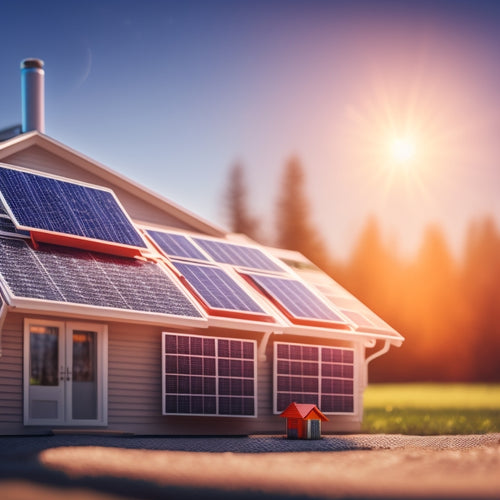
Diy Home Solar Kits
Share
By opting for a DIY home solar kit, you're taking the first step towards energy independence, reducing your reliance on fossil fuels and gaining control over your energy costs. Evaluating your energy needs is essential for determining the right kit size, and understanding the technology behind it, such as monocrystalline silicon cells, is key to maximizing energy harvest. Examining your roof's shading and obstructions is also important for peak efficiency. With higher efficiency cells converting more sunlight into energy, you'll be on your way to a more sustainable future - and there's more to investigate to make the most of your DIY solar kit.
The Essentials
- DIY home solar kits enable energy self-sufficiency and independence, reducing reliance on fossil fuels and grid outages.
- Assessing energy needs is crucial for determining the right solar kit size and optimizing energy output.
- Higher efficiency solar cells convert more sunlight into electrical energy, increasing output and making DIY solar kits more effective.
- Roof assessment is essential for solar installation, considering factors like shading, obstructions, and seasonal patterns.
- Transitioning to renewable energy with DIY solar kits reduces carbon footprint, promotes energy efficiency, and contributes to a healthier environment.
Grid Independence Matters Most
When you opt for a DIY home solar kit, you're not just installing a new system - you're gaining energy self-sufficiency.
With an all-encompassing DIY solution like a Solar Panel Kit, you'll have everything you need to utilize the power of the
Energy Self Sufficiency Now
As you strive to break free from reliance on the grid, energy self-sufficiency becomes a crucial concern, and achieving it now is essential for securing a sustainable future.
With the advancement of solar technology, you can take important steps towards energy autonomy. By utilizing the power of the sun, you can generate clean energy, reduce your reliance on fossil fuels, and minimize your carbon footprint.
Many individuals have already made the switch to DIY solar kits, overcoming common challenges such as high installation costs and complexity in determining the right equipment for their specific needs.
To achieve energy self-sufficiency, you'll need to assess your energy needs and determine the size of the solar kit required to meet those needs. A DIY home solar kit can provide you with the necessary components to get started.
These kits typically include solar panels, an inverter, and mounting hardware. By installing a solar kit, you can reduce your energy bills, increase your energy independence, and contribute to a cleaner environment.
Renewable Power Freedom
Since breaking free from the grid is a primary goal, achieving renewable power freedom takes center stage. You're not just looking to reduce your energy bills; you want to be in control of your energy needs.
By embracing off-grid living with solar energy solutions off-grid solar power, you can enjoy the benefits of unlimited clean energy and minimize your reliance on expensive generators or grid connection.
With DIY home solar kits, you can utilize the solar energy benefits and enjoy sustainable living. Renewable power freedom means you're no longer tied to the grid, and you can generate your own clean energy.
This independence is vital in the current landscape, where energy prices are unpredictable and the grid is vulnerable to outages. By going off-grid, you'll reduce your reliance on fossil fuels and minimize your carbon footprint.
With solar energy, you'll have a constant supply of power, even during blackouts or natural disasters. You'll also increase your property value and enjoy lower energy costs in the long run.
Reduced Carbon Footprint Guaranteed
You're switching to a DIY home solar kit, which means you're opting for an eco-friendly energy source that markedly reduces your reliance on fossil fuels.
By utilizing solar power, you'll cut down on greenhouse gas emissions, contributing less to climate change and air pollution.
With a DIY solar kit, you can expect a notable decrease in your carbon footprint, making your home a more sustainable and environmentally responsible abode.
As you make the shift to renewable energy, you'll not only reduce your energy bills but also increase your energy efficiency sustainable living.
Eco-Friendly Energy Source
With climate change becoming an increasingly pressing concern, utilizing eco-friendly energy sources has become a top priority for environmentally conscious homeowners. You're taking a significant step towards sustainable living by considering DIY home solar kits. These kits offer a viable solution for reducing your carbon footprint and relying on clean energy.
| Solar Panel Benefits | Description |
|---|---|
| Renewable Energy Source | Captures energy from the sun, reducing reliance on fossil fuels |
| Zero Emissions | Produces no greenhouse gas emissions or pollution |
| Energy Independence | Generates electricity on-site, reducing grid dependence |
| Low Maintenance | Solar panels require minimal upkeep and have a long lifespan |
| Cost-Effective | Reduces energy bills and increases property value |
Greenhouse Gas Reduction
Install DIY home solar kits to drastically cut down on your greenhouse gas emissions, guaranteeing a reduced carbon footprint. By utilizing renewable energy from the sun, you'll greatly lower your reliance on fossil fuels, a major contributor to climate change.
This shift to sustainable living not only benefits the environment but also your wallet, as you'll save on energy costs.
With DIY home solar kits, you can expect a substantial emission reduction. For instance, a typical residential solar panel system can offset around 3-4 tons of carbon dioxide emissions annually.
This is equivalent to planting over 100 trees or driving an electric vehicle for 10,000 miles. By choosing solar power, you're actively contributing to a cleaner, healthier environment for future generations.
Embracing sustainable living through DIY home solar kits is an essential step towards a greener tomorrow.
You'll be reducing your carbon footprint, conserving natural resources, and promoting energy independence.
Take the first step today and join the movement towards a more sustainable future.
Monocrystalline Silicon Cell Technology
You're likely interested in the performance of your DIY home solar kit, and that's where monocrystalline silicon cell technology comes in.
With an average cell efficiency rate of 20-22%, these cells outperform their polycrystalline counterparts, allowing you to generate more power per hour of sunlight.
High-efficiency solar panels, such as those offered by SunPower, are leading the way in residential solar energy solutions.
The quality of the silicon used in these cells also matters, as it directly impacts their ability to convert sunlight into usable electricity.
Cell Efficiency Rate
As sunlight hits the photovoltaic cells in your DIY home solar kit, it's the cell efficiency rate that determines how much electrical energy is generated. This rate is critical in evaluating the performance of your solar panel system.
Monocrystalline silicon cell technology, in particular, boasts a high cell efficiency rate, typically ranging from 15% to 20%. This means that for every unit of sunlight that hits the cells, 15% to 20% of it's converted into usable electricity.
When comparing the performance of different cell technologies, the cell efficiency rate is a key metric. A higher efficiency rate translates to more power output per unit area, making it ideal for residential installations where space is limited.
In contrast, lower-efficiency cells may require more surface area to generate the same amount of power, increasing installation costs and complexity. By choosing a high-efficiency cell technology like monocrystalline silicon, you can maximize your energy harvest and enjoy greater freedom from the grid.
Silicon Quality Matters
Nearly all high-efficiency solar panels rely on monocrystalline silicon cell technology, which owes its superior performance to the exceptional quality of its silicon crystals.
You'll find that top-tier manufacturers source their silicon from leading providers, guaranteeing the purest materials for their panels. When selecting a DIY home solar kit, you should prioritize silicon quality as well. Look for kits that employ high-purity silicon crystals, as these will directly impact your panel's efficiency.
Purity standards are vital in silicon production. The highest-grade silicon is refined to have fewer impurities, resulting in more efficient energy conversion.
You'll want to opt for a kit that boasts silicon with a purity level of at least 99.9999%. Anything less may compromise your system's overall performance.
When researching DIY home solar kits, investigate the silicon sources and purity standards employed by each manufacturer. This attention to detail will pay off in the long run, as high-quality silicon guarantees your system generates the maximum amount of energy possible.
Check Your Roof's Shading
You'll need to assess your roof's shading to guarantee your DIY solar kit operates at peak efficiency.
When considering renewable energy systems, it's crucial to evaluate your roof's compatibility with solar panels, including factors such as photovoltaic cells and mounting systems.
Consider roof obstructions like chimneys, vents, and skylights that can cast shadows on your solar panels.
Additionally, take into account shading patterns that change over time due to seasonal sun angles and surrounding vegetation.
Roof Obstructions to Consider
Before installing a DIY home solar kit, scrutinize your roof for obstructions that could cast shade on your solar panels. You'll want to identify any features that could block sunlight, reducing your system's energy output.
Start by evaluating your roof's orientation and how it affects the installation angle of your solar panels. A south-facing roof with an installation angle between 30-40 degrees is ideal, as it maximizes energy production.
Next, inspect your roof for physical obstructions like vents, skylights, and chimneys. These features can cast partial shade on your solar panels, reducing their efficiency. Consider relocating or removing them if possible.
Also, take note of nearby trees or buildings that could cast shade on your roof, especially during peak sun hours.
Shading Patterns Over Time
Across different times of the year, your roof's shading patterns change due to the sun's varying position in the sky. This means you'll need to evaluate the seasonal variations in shading when planning your DIY solar kit installation. A thorough shading analysis will help you identify potential issues and enhance your system's performance.
| Season | Shading Effects | Performance Impact |
|---|---|---|
| Winter | Longer shadows from surrounding trees and buildings | Reduced energy output (10-20%) |
| Spring/Fall | Shading from trees and roof obstructions | Moderate energy output (5-10%) |
| Summer | Least amount of shading due to high sun path | Ideal energy output |
To mitigate shading effects, examine the following:
- Analyze your roof's orientation and nearby obstructions
- Plan your installation timing to avoid peak shading seasons
- Trim or remove trees and obstructions to minimize shading
- Think about using shading mitigation strategies, such as panel layout optimization or module-level power electronics
Higher Energy Conversion Rate
You'll want to opt for higher efficiency cells in your DIY home solar kit to maximize your energy conversion rate.
These cells boast a higher power output per unit area, allowing you to generate more electricity from the same amount of sunlight.
Higher Efficiency Cells
Higher efficiency solar cells boast a superior ability to convert sunlight into electrical energy, resulting in more power output per hour of sunlight. This means you'll generate more electricity with the same amount of sunlight, making your DIY solar kit more effective.
With higher efficiency cells, you'll notice a significant increase in your overall energy production.
When selecting higher efficiency cells, you'll want to evaluate cell durability and maintenance requirements. Cells with higher efficiencies often come with enhanced durability, guaranteeing they can withstand harsh weather conditions and last longer.
This reduces the need for frequent maintenance and replacements, saving you time and money in the long run. Look for cells with a high IP67 rating, which guarantees protection against dust and water ingression.
Additionally, assess cells with a 25-year warranty or more, which ensures you're covered in case of any defects or performance issues.
Frequently Asked Questions
Can I Install a DIY Solar Kit on a Metal Roof?
When installing solar panels on a metal roof, you'll face unique challenges, such as ensuring watertight seals and avoiding corrosion; consider specialized mounting systems and consult local building codes to overcome these metal roof considerations.
Are DIY Solar Kits Compatible With Power Grid Fluctuations?
When you generate renewable energy, you're likely wondering if your system can handle power grid fluctuations. You'll face compatibility concerns, but rest easy, modern inverters guarantee grid stability, allowing you to utilize solar power while maintaining a reliable connection to the grid.
Do DIY Solar Kits Come With a Warranty or Guarantee?
Coincidentally, you're not alone in seeking protection for your investment. You'll find that many solar kits come with warranties, offering peace of mind. Typically, they include 25-year performance warranties, 10-year equipment warranties, and installation support guarantees, ensuring your freedom from worry.
Can I Expand My DIY Solar Kit in the Future?
You can future-proof your system by choosing scalable components, allowing you to add solar panel upgrades and energy storage options as needed, giving you the freedom to expand and adapt your renewable energy setup at will.
Are DIY Solar Kits Suitable for Small Off-Grid Cabins?
When escaping the grid, you'll find that small off-grid cabins thrive on self-sufficiency; DIY solar kits, offering cost efficiency and a streamlined installation process, become an ideal choice, enabling you to utilize the sun's energy and live off the land.
Final Thoughts
You've made it to the end of the DIY home solar kit expedition, and ironically, you're now more dependent on the sun than ever before. But this time, it's a good kind of dependence - one that brings you grid independence, a reduced carbon footprint, and a higher energy conversion rate. With monocrystalline silicon cell technology, you're utilizing the power of the sun like a pro. Just remember to check your roof's shading, and you'll be generating clean energy in no time. Congratulations, you're now a solar energy expert!
Related Posts
-

A Beginner's Guide to Navigating the Solar Investment Tax Credit
You're eligible to claim a significant Solar Investment Tax Credit (ITC) of 30% of total installation costs, but mane...
-

Essential Hiking Lights for Safety and Fun
When you're hitting the trails, essential hiking lights are vital for safety and fun. A lightweight headlamp offers h...
-

Smart Grid Technology Implementation Challenges
You'll encounter several challenges when implementing smart grid technology, particularly in cost management, scalabi...


